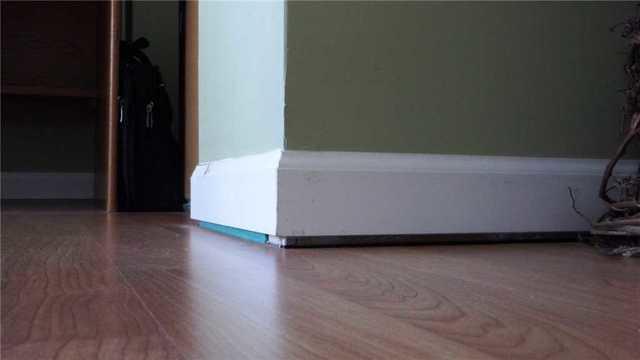
Gaps Between Floor and Baseboard Indicative of Sinking Floors
It's one thing to feel a soft spot in your floor. It's quite another to see visible space between where your floors used to be and where they are now. The extra square footage isn't worth the possibility of waking up in your crawl space one day.

Gap Between Baseboard and Floor
Sometimes it's more than just a sag in the middle of the floor - these floors are literally sinking, and sinking badly enough for there to be visible space between them and the baseboard.

Floors Sink and Pull Away from Baseboard
Here's another wall where the floor is sinking, leaving behind visible space between the floor's new location and it's original spot.

Sagging, Sinking, Tilted Floors in Houghton Lake Heights Home
The visible tilt to the floor and the gaps between the floor and the baseboard are both signs that something is Very Wrong in the crawl space.

Crack Emanating from Floor
As the floor shifts, the walls experience pressure and support changes, which can result in cracks like this.

Gap Between Wall and Roof
As the sinking floor causes the wall to shift, this also affects the relationship between the walls and the roof. Here, the wall leans in, separating it from the porch roof.

Visible Cracks Where Wall Meets Ceiling
Inside, the wall/ceiling relationship isn't much better, As the newly shifted walls lean, cracks can form at the ceiling.

Wall Crack at Support Point
This portion of the wall supports an upstairs loft space of sorts - and clearly, the collapsing crawl space isn't helping it do its job. With the walls shifting, they aren't stable and able to support weight.

Close-Up of Wall Crack
This isn't a superficial scrap in a wall - this is what happens when the drywall is under far too much stress.

Diagonal Crack in Doorway
Diagonal cracks in doorways and windows are another sign of foundation problems. As the floor sinks, the wall also shifts, and cracks form at vulnerable points like these cutouts.

Shifting Wall Pulling Away from Ceiling
As the wall shifts with the sinking floor, it pulls at the drywall tape placed at the seams. This, in turns, pulls at the paint, as shown here. If there are no walls adequately supporting the ceiling, the home's stability is even further at risk.

Poorly Patched Crack in Archway
Someone tried to patch this crack, likely with spackle, not realizing that it was caused by constant sinking and the affects of gravity.

Kitchen Counter Separates from Wall
You may have seen something like this and thought the countertop was to blame. But it's actually a sign that your floors are sinking. As the floor below it sinks, the countertop naturally sinks and, in the process, pulls away from the wall.

Sinking Countertop Pulls Away from Wall
Not only is the sinking countertop a sign of a sinking floor, but it becomes an inconvenience as it tilts forward. Hope you don't plan on storing apples up there.









